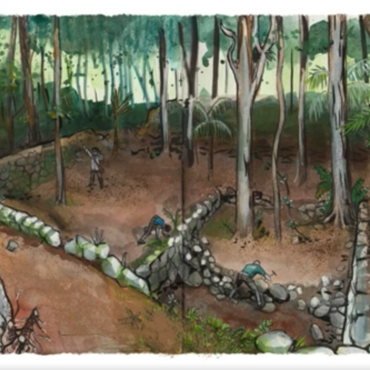
- Home
- Archaeology on Reunion Island
- Sites
- Saint-Denis
- Îlet à Guillaume
- Cilaos
- La Possession
- Saint-André
- Saint-Benoît
-
Saint-Denis
- 119 rue Jean Chatel
- Cells in the Saint-Bernard leprosaria
- Caserne Lambert
- Railway station
- La Grande Chaloupe station
- Îlet à Guillaume
- Lazarets de la Grande Chaloupe
- Schneider et Cie steam locomotive
- Marine du Butor
- New Western Entrance
- La Providence
- Place du Général de Gaulle
- Port du Barachois
- Juliette Dodu Prison
- Quadrilatère océan
- The "Redoute Bourbon"
- Rue de la Batterie
- Saint-Joseph
- Saint-Leu
- Saint-Louis
- Saint-Paul
- Saint-Pierre
- Saint-Philippe
- Sainte-Rose
- Sainte-Suzanne
- Salazie
A 19th century prison colony
The remains of a prison colony for children in use from 1864 to 1879 have been discovered on the Îlet à Guillaume plateau. This five-hectare remote plateau, at an altitude of 700 metres, which may have been a marronnage site, was put under cultivation from the early 19th century. The prison was built by missionaries from the Congrégation du Saint-Esprit. This religious organisation also ran the leper colony at Saint-Bernard and the Domaine de La Providence, the site of the first prison for children. Supervised by the Spiritan Fathers, up to 180 children built a water distribution system, accommodation, two successive chapels and workshops as well as embankments and agricultural enclosures. They laid an access road from La Fenêtre, where the remains of the ‘case’ or cottage of Frère Alexandre are still visible, which was a stage on the road from Saint-Denis.
The child prisoners farmed and harvested crops, supervised the farmyard animals and worked in the forge and sawmill. The living conditions imposed by the priests were extremely harsh but rarely criticised, adding to tensions between the clerical world and the colony, which was now secular and republican, and led to its ultimate demise. The decision to close it was made in 1871, and implemented in 1879.
The plateau was temporarily settled before being abandoned and then planted with trees by the national forestry office (ONF) between the 1950s and 1970s. The landscape attests to its different uses over time.
A historical study and an initial archaeological operation in 2020
After the Îlet à Guillaume site was 3D-mapped in 2019, the Département de La Réunion launched an archaeological and historical study in October 2020 to shed light on the former children’s prison at Îlet à Guillaume, which has been listed as a historical monument since 2008.
To learn more about the operation organised by Inrap in 2020, watch the news report filmed in the field.
Associated media
Open Media Library

LIDAR scan (Saint-Denis, Îlet à Guillaume)

3D model (Saint-Denis, Îlet à Guillaume, 2020)

General plan (Saint-Denis, Îlet à Guillaume, 2020)

Pénitencier de l'Ilette à Guillaume

Animal yard (Saint-Denis, Îlet à Guillaume)

Study mission (Saint-Denis, Îlet à Guillaume, 2020)

Topography (Saint-Denis, Îlet à Guillaume, 2020)

Archaeobotany (Saint-Denis, Îlet à Guillaume, 2020)

